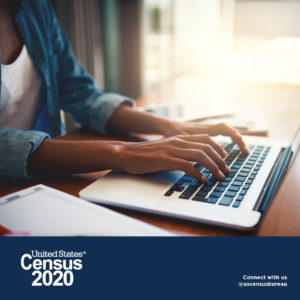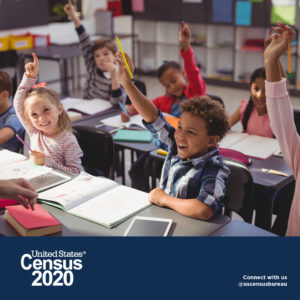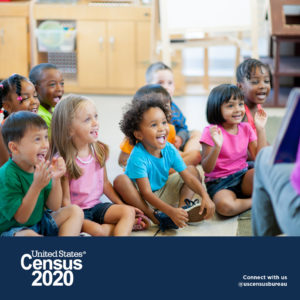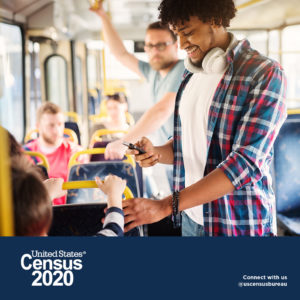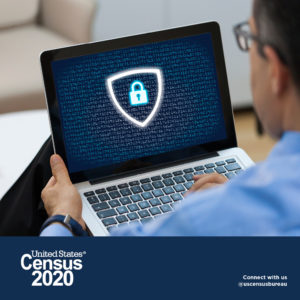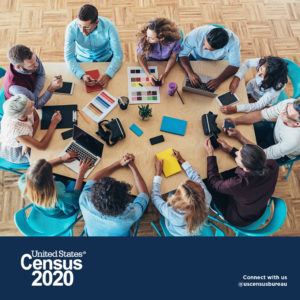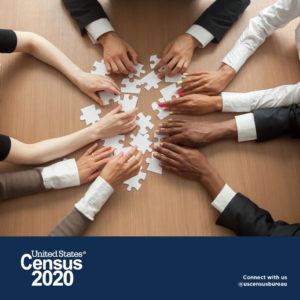Census 2020
Updates on the Census and COVID-19 can be found here.
The ten question Census will be largely digital for the first time, and there are a lot of communities and populations that stand to be left out of the count, including traditionally hard-to-count populations like children, New Americans, and people with limited access to internet and limited experience with technology.
There are a lot of things tied to the Census, including the basic tenets of democracy and representation in our State and Federal government, and, what resonates more with people in studies, state and federal funds received locally; young families are more likely to participate in the Census when they find out it affects funding for their community. Federal funding for Medicaid, local schools, highway planning and construction, CHIP, WIC, SNAP, HEAP, and more are distributed using formulas based on the decennial Census. Similar formulas based on the Census or based on formulas based on the Census are used to allocate state funding for programs like the Community Development Block Grant Program, and Census data is used for planning purposes by businesses and nonprofits. An inaccurate count will result in lost funding, which helps offset state and local funds, and reduced representation at the state and federal levels.
Libraries can help ensure a complete count by partnering with Community Based Organizations, local governments, and anyone interested in getting the word out about the Census. Libraries can also provide support as tech hubs and trusted organizations in their community.
We’ve gathered the following resources to help libraries understand the Census and how they can provide support for complete counts in their communities.
To get started promoting and preparing for the Census now,
check the Sample Get Out the Count Timeline.
- Census Background
- Sharing the Importance of the Census with your Community
- Maps of Hard-To-Count Communities and Types of Enumeration Area
- Guides to the Organizing and Complete Count Committees
- Preparing Technology and Computers for the Digital Census
- Documentation and Studies
.
.
Census Background
2020 Census Webinar from MHLS
Jump to sections of the 2020 Census Webinar:
- Why the Census is important
- Hard-to-Count populations
- Map of Hard-to-Count Census tracts and 2010 Census Response Rates in the Mid-Hudson Library System service area
- Title XIII and privacy of reported Census data
- Programs with funds allocated based on Census population counts
- Census Funding per capita in New York State
- What libraries can do to promote and prepare fore Census
- What questions are on the Census
- Who should be counted
- Map of how people will be invited to respond to the Census
- Map of communities with young children at risk to be under counted
- Enumeration timeline
- Sample Census self-response invitation
- Digital security best practice
- List of resources to support complete counts and helping people complete the Census
- List of phone numbers for complete the Census questionnaire by phone
Preview of the 2020 Census Online Questionnaire
Timeline
[Source: U.S. Census Bureau] Click for full image.- Key 2020 Census Milestones – Timeline of Census activity.
- January 2020 – Census Questionnaire Assistance will be available to answer general questions about the census from mid-January through early September 2020. However, the self-response period for the telephone option will run from mid-March through the end of July.
- February 2020 – The Census Bureau will contact administrators of group quarters (military barracks, college dorms, prisons, and skilled nursing homes, among others) in advance of the enumeration of these locations, which will occur in April.
- March 12, 2020– The internet self-response period will start as households begin to receive invitations to respond, either through the mail or hand-delivered to households in many rural and remote areas. Households may continue to self-respond through July 31.
- March 30, 2020 – Service-Based Enumeration (SBE) will begin. This three-day/night enumeration occurs at shelters, locations that provide services for people experiencing homelessness, and targeted outdoor locations where people experiencing homelessness sleep.
- April 1, 2020 – Census Day! Respondents do not have to wait until April 1 to respond but should include everyone who will be a “usual resident” on April 1. If people aren’t sure, they can wait until April 1 to respond.
- April 2020 – Group quarters will be counted during April.
- August 11, 2020 – Nonresponse Follow-up (NRFU) will begin. During NRFU, the Census Bureau will follow up with households that did not self-respond to the census by sending reminders and/or visiting in person. NRFU will continue through July. (In communities with large numbers of off-campus college students, NRFU will begin on April 9, to reach students before the academic term ends.)
- How the 2020 Census will invite everyone to respond – Outline and timeline of how the call for responses will be conducted from the U.S. Census Bureau.
- Enumeration Timeline
- January 21 Enumeration kicks off in remote Alaska
- March 10 Start of field supervisor training
- March 27 Start of enumerator training
- March 12 – April 30 Self-Response Operation
- March 12-20 Mailing 1
- March 16-24 Mailing 2: Reminder letter
- March 26 – April 3 Mailing 3: Reminder postcard
- April 8-16 Mailing 4: Reminder letter plus paper questionnaire
- April 20-27 Mailing 5: “It’s not too late” postcard
- July 22 – Additional Mailing postcard due to COVID-19
- August 11 – Non-Response Follow-Up
- October 31 Last day for households to self-respond online, by phone or by mail
.
.
Sharing the Importance of the Census with your Community
Studies and tests carried out by the Census Bureau show that people are not motivated to complete their Census questionnaire and don’t see a connection between completing the Census and their own lives. One of the most important things the library can do to ensure everyone is counted is to get the word out that the Census is coming, and that funding for things they care about in their community will be affected if they fail to complete the Census. You can use the graphics and videos below to highlight the coming Census in your newsletters, social media channels and other outlets.
Graphics for Social Media
Videos for Social Media
How Do I Take the 2020 Census?
Census Basics
Shape Your Future
How the Census Protects Your Data and Privacy
How Will 2020 Census Data Be Used?
2020 Census PSA: They Also Count (Spanish)
2020 Census PSA: How Does the 2020 Census Affect Representation?
Statistics in Schools & the 2020 Census PSA: Today I Learned
2020 Census PSA: Every Moment Counts
.
Fliers
.
Newsletter Articles
- The 2020 Census is Coming
Did you know funding for our local schools, Head Start programs, roads, Medicaid, community development grants, roads, and more are all based on how many people are counted in the Census? Your response to the 2020 Census will affect not only the funding we receive for these important resources in our community, but also our representation in the federal and state governments. The Census asks 10 basic questions about each person in your household, including name, date of birth, sex, and race. With a lot at stake, we’re gearing up at the library to make sure everyone knows about the Census and has the opportunity to be counted. For the first time the Census will be available digitally nationwide using your phone, tablet, or computer. Everyone will have the option to respond online or by phone, and some people will also have the option to respond using a paper questionnaire. The library will be here to help answer questions, and provide a secure environment for people to complete the Census online if they need one.
Fore more information, visit www.2020Census.gov. - The Census is Almost Here!
It’s important that everyone be counted in the upcoming Census. The federal and state governments use the results of the Census to allocate billions in funding for schools, Head Start programs, roads, Medicaid, community development grants, roads, and more. Go to www.2020Census.gov to complete your Census questionnaire now, and secure funding for these important resources for our community. Your answers to these 10 basic questions will also protect our representation in federal and state governments. When you receive your invitation to respond to the Census, you will be asked to respond online or by phone, and some people will have the option to respond using a paper questionnaire. To respond online, you can use your Census ID number which will come in the mail or, if you don’t have that, your home address. The library is here to help answer your questions about the Census and provide a secure environment for you and your neighbors to complete the questionnaire online if needed. So help yourself, help your neighbors, complete the Census and let your friends know they should do it to!
Fore more information, visit www.2020Census.gov. - The Census is Here!
Have you completed your Census yet??? Did you do it online or by phone, or did you get a paper questionnaires? Your response to the Census secures our community’s right to fair representation in the federal and state governments, and our share of billions in federal and state funding including money for schools, community development grants, roads, Medicaid, and more. The Census asks some basic questions about everyone in your household, including children born on our before April 1, 2020, but this short quiz, which asks for less personal information than Google, Facebook, or even completing your taxes, can have a big impact for you and your neighbors. That’s why the library is here to answer questions about the Census and provide secure access to www.2020Census.gov. On behalf of the library and your community, we want to say, “thank you,” if you already completed the Census, and if you haven’t yet, it’s not too late! Responding is your civic duty, and also required by law, so head over to www.2020Census.gov to fill out your questionnaire!
Fore more information, visit www.2020Census.gov.
Spanish Support Phrases
- Phrases to support Spanish-speaking community members to understand the importance of the Census and complete the Census.
.
More Resources
- 2020 Census Mailings – Includes reference documents that show what 2020 Census invitations will look like.
- Promotional Materials and Guidelines from the US Census – Guides and tool kits for promoting the Census to your community.
- PSA Toolkit – The Census Bureau provides resources to help ensure partners and stakeholders have the tools they need to effectively engage their communities.
- Dollars And Census Planet Money Podcast – This podcast provides a quick 7 minute background on the Census, along with an overview of how the Census determines how much federal funding districts get, and how many congressional representatives they get to elect.
- Statistics in Schools – Lesson plans that can be adapted for library programs to create awareness about the Census.
- Pre-K Materials – Entertain and educate young children with a storybook, song, and interactive activities that involve counting and learning about their community. These resources—available in both English and Spanish—explain the 2020 Census and introduce children to the concept of data and the importance of numbers in a fun and simple way.
- K-12 Activities – Find activities specially designed to be engaging and appropriate for your students’ grade level, from counting for kindergarteners to examining career statistics for high schoolers. Each activity also teaches your students about the importance of a complete count in the 2020 Census.
- Census Jobs – A complete count will take work, and the Census needs more people working to get everyone counted. Libraries can direct people to this site to apply for Census jobs.
- Hudson Valley Hard-to-Count Census 2020 Grant – Community Foundations of the Hudson Valley offering grants for outreach to Hard-to-Count communities (due December 8, 2019).
- Next Century Cities’ 2020 Census Kiosk Toolkit – Provides resources for sourcing equipment and configuring Census Kiosks, along with resources for organizing and outreach efforts.
- Why We Ask – Promotional handout from the U.S. Census Bureau about the importance of each question on the Census questionnaire.
- Nickelodeon Community Videos – Videos, activity sheets, posters and stickers, available in Spanish and English to promote the Census using Nickelodeon characters.
.
.
Maps of Hard-To-Count Communities and Types of Enumeration Area
- Daily 2020 Self-Response Rates Map – View up-to-date response rates to see how many people in your community responded to the Census by state, county, census tract, and town.
- Hard to Count Population Map with Libraries – Use this map to find hard-to-count(HTC) populations in your community. This map includes overlays that help you see where HTC populations are located, what type of mail contact strategy the Census plans for each area, and where libraries are located. Hard-to-count populations are communities and groups with historically low response rates to the Census including, young children, highly mobile persons, racial and ethnic minorities, non-English speakers, low income persons, persons experiencing homelessness, undocumented immigrants, persons who distrust the government, LGBTQ persons, persons with mental or physical disabilities, persons who do not live in traditional housing.
- Mail Contact Strategies Viewer – This interactive map shows how the country will be asked to respond to the 2020 Census. Nearly every household will be invited to respond online, by phone or by mail to the census starting in mid-March 2020. Most areas—about three of every four households—will receive an invitation to respond online (or by phone), while the other households will receive a paper questionnaire along with an invitation to respond online. More info about mail contact strategies at the Center for Urban Research.
- Contact strategies listed include:
- Internet First, English – Will receive a mailing in English with instructions to complete the census questionnaire online or by phone.
- Internet First, Bilingual – Will receive a mailing in Spanish and English with instructions to complete the census questionnaire online or by phone.
- Internet Choice, English – Will receive a mailing in English with instructions to respond online or by phone, along with a paper questionnaire, which can be used to respond.
- Internet Choice, Bilingual – Will receive a mailing in Spanish and English with instructions to respond online or by phone, along with a paper questionnaire, which can be used to respond.
- Contact strategies listed include:
- Broadband Access and Adoption Map by Census Tract – Maps broadband access in the U.S.
- Children’s Under-count Risk Map – An interactive map with risk levels for under-counting children coded by Census tract.
- 2020 Census Type of Enumeration Area (TEA) – An interactive map showing the type of enumeration the Census plans to use for each area.
- Types of Enumeration include:
- Self-Response – designed to occur in areas where the majority of housing units have mail delivered to the physical location of the housing unit. Self-Response is the primary enumeration methodology for the 2020 Census. Self response will likely be a piece of mail that includes a unique Census ID number, which residents will use in their self-response online, by phone, or through paper.
Note: the Census ID number is good to use when completing the Census, but it is not necessary to complete the Census. Census responses without Census ID numbers will be matched to their address and Census ID number later to avoid duplicate responses. - Update Leave (UL) – designed to occur in areas where the majority of housing units either do not have mail delivered to the physical location of the housing unit, or the mail delivery information for the housing unit cannot be verified. This type of enumeration involves verifying the address and living quarters and leaving an internet self-response form.
- Update Enumerate (UE) – designed to occur in areas where the initial visit requires enumerating while updating the address frame. UE will occur in areas that were part of the 2010 Census Remote UE Operation, such as northern parts of Maine and southeast Alaska, as well as select American Indian areas that request to be enumerated in person during the initial visit.
- Military – designed to occur in areas on military installations.
- Self-Response – designed to occur in areas where the majority of housing units have mail delivered to the physical location of the housing unit. Self-Response is the primary enumeration methodology for the 2020 Census. Self response will likely be a piece of mail that includes a unique Census ID number, which residents will use in their self-response online, by phone, or through paper.
- Types of Enumeration include:
- Complete Count Committee Map – Find your local Complete Count Committee. Email census.cccmap.list@census.gov to get your CCC on the map.
- The Response Outreach Area Mapper (ROAM) – A mapping application of predicted mail nonresponse rate to the Census. This application was developed to make it easier to identify hard-to-survey areas and to provide a socioeconomic and demographic characteristic profile of these areas using American Community Survey (ACS) estimates available in the Planning Database. Learning about each hard-to-survey area allows the U.S. Census Bureau to create a tailored communication and partnership campaign, and to plan for field resources including hiring staff with language skills. These and other efforts can improve response rates.
.
.
Guides to the Organizing and Complete Count Committees
- Census Sample Questionnaire – view the questions that will be on the Census.
- Sample Self-Response Invitation – view the letters you and your neighbors will receive.
- Libraries Guide to the 2020 Census – The American Library Association’s guide to the Census and libraries’ role.
- Libraries and the 2020 Census (ALA) – Brief on how and why libraries are an important part of Complete Count efforts all over the country.
- 2020 Census Complete Count Committee Guide – Complete Count Committees (CCC) are volunteer committees established by tribal, state, and local governments and community leaders or organizations to increase awareness and motivate residents to respond to the 2020 Census.
- Preparing for the First Digital Census – A manual for libraries, community-based organizations, and community advocates from the New School meant for anyone who intends to work with communities towards a complete county during Census 2020.
- 2020Census.gov – Official page of the Census with answers to frequently asked questions.
- New York State Libraries: Guide to the 2020 Census – Guide to the Census for New York libraries.
- A Roadmap to Achieving a Complete 2020 Census Count in New York State – Final Report New York State Complete Count Commission
- Census 2020 Resources from the New York State Division of Library Development – The web page was created by the New York State Library as a resource to emphasize the important role libraries play in creating awareness of the Census and by providing internet access for completing the Census online. The sites included on this web page include complete count information and resources from the U.S. Census Bureau.
- Getting Ready for Census 2020 (NYLA)
- Governor Cuomo Announces $60 Million to Support Counting Every New Yorker in the 2020 Census – Grant funds will be distributed according to criteria including presence of cooperating libraries and other institutions.
.
.
Preparing Technology and Computers for the Digital Census
For the first time, residents all over the United States will be invited to complete the decennial Census online using a computer, smart phone, tablet, or other device. Each invitation to complete the Census digitally will also include an option to complete the Census by phone, but the Census Bureau’s preferred method of completing the Census is digitally. Below are some simple precautions you can take to ensure responses for residents completing the Census questionnaire online at the library are kept safe and private.
- Procure additional computers or devices necessary to support people completing the online Census questionnaire.
- Ensure computers and devices designated for completing the Census have Windows 10 or another supported operating system installed (support for Windows 7 ends January 14, 2020)
- Ensure computers and devices designated for completing the Census have up-to-date web browser software.
- Ensure computers and devices designated for completing the Census are free of viruses and malware.
- Ensure computers and devices designated for completing the Census have up-to-date antivirus software.
- Ensure Deep Freeze software or other hardware locking software is up to date.
- Encourage patrons to restart the computer after they have completed their questionnaire to erase any lingering data.
- Ensure kiosk mode is enabled for computers and devices dedicated solely to completing the Census.
- Ensure public wifi networks are secured and encrypted. For Aerohive routers managed by MHLS contact techsupport@midhudson.org to determine your configuration.
- Ensure private mode is enabled by default for computers and devices dedicated solely to completing the Census.
- Do not plugin unknown devices into computers dedicated to completing the Census. After removing a device, like a USB drive, restarting a computer with Deep Freeze will return the software to the previous saved state before the device was plugged in. Remove any thumb drive or other suspicious devices connected to computers and devices designated for completing the Census.
- For more in-depth info about preparing technology for the Census, see Preparing for the Digital Decennial Census: Building consent, equity, and safety into digital transition from the Digital Equity Lab.
.
.
Documentation and Studies
- Title 13, U.S. Code – The privacy of information recorded in the Census is taken very seriously. Private information is never published. It is against the law to disclose or publish any private information that identifies an individual or business such, including names, addresses (including GPS coordinates), Social Security Numbers, and telephone numbers. Violating the law is a serious federal crime. Anyone who violates this law will face severe penalties, including a federal prison sentence of up to five years, a fine of up to $250,000, or both.
- Kids Count 2018 from Annie E. Casey Foundation – The 2010 U.S. Census failed to count almost 1 million children younger than age 5, and we could make the same mistake in the 2020 Census.
- New York State Census Focus Groups with Families with Young Children – All participants were unaware that the census affected the levels of funding, and they generally felt that that is a crucial reason to fill out the census.
- It Pays to be Counted – New York stands to lose $2,600 for each person that goes uncounted.
- Census Barriers, Attitudes and Motivators Study – Two-thirds of respondents are “extremely likely” or “very likely” to fill out a census form. Many people were unfamiliar with the census, with only 33 percent being “extremely” or “very” familiar. Knowledge about the purpose and process of the census was uneven across groups. The analysis revealed five barriers that might prevent people from participating in the census: concerns about data privacy and confidentiality, fear of repercussions, distrust in all levels of government, feeling that it doesn’t matter if you are counted, and belief that completing the census might not benefit you personally. Funding for public services was a top motivator across groups, yet less than half of respondents knew that the census is used to determine community funding.
- Preparing for the Digital Decennial Census: Building consent, equity, and safety into digital transition – An analysis of risk, safety and trust for the first-ever digital decennial census from the New School’s Digital Equity Laboratory (DEL), a nonpartisan university center dedicated to advancing digital equity through applied research, convening power, and leadership development.
- Counting for Dollars Project– This project will identify all federal financial assistance programs relying Decennial Census-derived data to guide the geographic distribution of funds.
For more info contact Casey Conlin at cconlin@midhudson.org.
